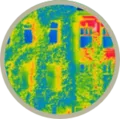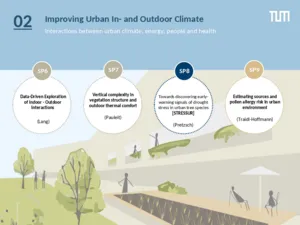Research Cluster 2: Improving Urban In- and Outdoor Climate
Head: Werner Lang
Due to the high density of buildings, the related thermal storage capacities, reduced air movement, intensity of heat sources such as buildings and cars, high degree of sealed surfaces, and lack of green areas, cities are hotter than the countryside. Because of the urban heat effect, climate change has a particularly strong impact on dense settlement structures, especially during the night, when high air and radiation temperatures have a negative influence on health and the quality of sleep of the urban population.
RC2 aims at the improvement of the urban in- and outdoor climate by
(i) assessing the causes and magnitude of the before-mentioned negative effects on human comfort and health; and
(ii) developing solutions to overcome these challenges by employing the main RTG strategies.
UGI as a substitution strategy can help to regulate the (micro)climate by providing shade, acting as windbreaks, and cooling public areas and the immediate surroundings of buildings through evapotranspiration. Furthermore, plants absorb CO2 and store carbon, while O2 is released into the atmosphere. Green unsealed areas and the soil with the deposition of pollutants can serve as a source of nutrients to UGI, as well as a water reservoir during heavy rain.
To fully understand the effects of outdoor UGI on indoor heating and cooling, and occupant’s thermal comfort, the underlying dynamics of plants and vegetation, the response patterns to different climatic and growth conditions, and the combined (dis)services of different tree species close collaboration within Cluster 2 (SP6 - Energy, SP7 - Microclimate, SP8 - Urban Trees, SP9 - Health) and with Cluster 1 (SP3 - Reconstruction, SP5 - Design) and Cluster 3 (SP10 - Drainage, SP12 - Microbiome) is required.
Cluster 2 explores the potential of the integration of UGI in inner cities to improve in- and outdoor comfort and to reduce energy consumption and the related carbon footprints in a changing climate and thereby also substitute technical systems. Mapping, modeling and prediction of UGI, including trees, hedges, lawns, roof and facade greening, will be an essential basis for the projects similar to that of Cluster 1 (SP3 - Reconstruction, SP5 - Design) and Cluster 3 (SP10 - Drainage, SP12 - Microbiome), as they all build on UGI, and aim at their structural and functional improvement. Another important aspect to address in RC2 is the operationalization of the relevant measures (substitution, integration) by analyzing the performance of the suggested strategies and the options for integration and implementation of the relevant measures into the transformation and design process. It is necessary to bridge the gap between theoretical analysis and the implementation of the developed methods in the context of complex urban planning processes. To achieve this, close collaboration within RC2 and with RC1 (SP1 - Biodiversity, SP2 - Mobility, SP4 - Governance) is required.
The subprojects of research cluster 2 are

PI: Prof. Dr.-Ing. Werner Lang
PhD candidates: Fatma Deghim
Dissertation: Data-Driven Exploration of Indoor - Outdoor Interactions
Background: Urban microclimate significantly affects buildings and vice versa. Hence, interventions in one will have a strong impact on the other. Research has investigated this relationship and found urban green infrastructure to be an important lever therein. In the first phase of this Research Training Group, SP6 studied the interactions between indoor and outdoor spaces and demonstrated how green infrastructure can strategically be used to manage the trade-offs between the target dimensions of building energy demand, global warming potential, costs, and thermal comfort. However, these investigations were limited to case studies and the chosen sustainability aspects. It became clear that integrating more data on urban environments is crucial to capturing the significant complexities that arise from indoor-outdoor interactions and to facilitate informed decision-making in urban planning.
Therefore, one of the objectives of SP6 in the second phase of this Research Training Group is to analyze the predominant interactions within the grey-green-blue nexus in urban neighborhoods and to investigate the limitations of existing simulation workflows in capturing those interactions. This shall be achieved by using sensor data in combination with digital tools (e. g. GIS, indoor / outdoor simulations).
In the next step, SP6 aims to develop surrogate models that allow a faster and more accurate coupling of indoor-outdoor spaces than physics-based simulations. Data-driven methods have demonstrated these capabilities in the field of microclimate modeling. Studies have shown promising results, particularly in analyzing the relationships between air temperature and variables such as vegetation, surface sealing, and urban form. However, existing approaches do not include all urban elements systemically or allow for a holistic assessment of urban environments, e.g. vegetation is often underrepresented when creating data-driven models.
Another gap in urban analysis resides in the different scales in time and space and the use of different tools and methods to model various urban layers, such as buildings, trees, or public spaces. This increases data compatibility and modeling issues. Hence, the question of relevant data types and input parameters for data-driven modeling in the built environment will also be addressed.
Finally, SP6 aims to utilize the data-driven models to explore green-blue-grey design options in urban planning and to support urban decision-making in early design phases with many target dimensions. Sensitivity analysis, uncertainty analysis, and the application in a case study are the methodological bases for this step. Thereby, SP6 will provide a scientific foundation for deriving decision support in urban design processes, where numerous sustainability aspects must be considered simultaneously.

PI: Prof. Dr.-Ing. Stephan Pauleit, Dr. Mohammad Rahman
Affiliated researchers: Eleonora Franceschi
PhD candidate: Azharul Islam
Dissertation: Vertical complexity in vegetation structure and outdoor thermal comfort
Goals: The research aims to address the increasing urban heat island effect, which negatively affects human health and well-being, by studying how layered vegetation structures can enhance cooling efficiency and inform climate-resilient urban planning. Results from previous research in the RTG already showed the promise of a combination of tree, shrub and grass lawns, although trees were almost three times more effective in air cooling than shrubs, and shrubs were double as effective as grasses. However, relative effect sizes of the eco-physiological and morphological traits of different tree species at different growth conditions regarding planting and design strategies are yet to be explored. Therefore, it is important to have a 3D structural analysis of complex vegetation structures, followed by an assessment of microclimatic thermal regulations in contrasting scenarios and finally, to evaluate multidimensional canopy quality, facilitating the scaling from site to urban neighbourhoods.
The main research questions are:
Does plant vertical diversity bring added benefit to thermal regulations?
Which plant functional traits have the largest influence on cooling benefits in relation to vertical heterogeneity?
How to optimize the vegetation vertical structure to enhance the thermal regulation in different urban settings/ or open spaces/ urban environments?
Intended methods: Terrestrial (TLS) and aerial (ALS) laser scanning will be used to estimate tree and shrub crown volume, leaf area density, and canopy structure, while environmental data and ground based infrared thermal imaging will assess surface temperature. This data will overlay a LiDAR map to analyze how surfaces retain/release heat. To gain a better mechanistic understanding of the interactions between urban greens and the built environment in terms of thermal regulations, the three-dimensional computational fluid dynamic (CFD) model ENVI-met and scenario analysis across selected urban and suburban areas will be carried out. While the model can provide spatially and temporally highly resolved assessment of micrometeorological conditions, it does not yet incorporate the effect of tree dynamics (growth, evapotranspiration) in different urban environments. By incorporating field measurements on transpiration, heat flux, and tree growth dynamics, the project aims to optimize urban tree planting strategies for enhanced cooling, thermal comfort, and climate change mitigation. ENVI-met will simulate optimized thermal comfort using multi-layered tree and shrub structures, along with green coverage in urban areas, incorporating optimized air temperature predictions from the CityTree dynamic growth model. The links between microclimate and growth models will focus on the thermal impacts of urban trees, including their structure, shading, and cooling effects, to enhance thermal regulation.

PI: Prof. Dr. Richard L. Peters
Affiliated researchers: Dr. Torben Hilmers
PhD Candidate: Sierra Quinn McKinney
Dissertation: Towards discovering early-warning signals of drought stress in urban tree species [STRESSUR]
Background: As climate change accelerates, trees in urban environments are increasingly exposed to atmospheric drought due to the rising vapor pressure deficit (VPD). This environmental shift forces trees to close their stomata in an attempt to conserve water and avoid lethal embolisms. In urban areas, this stress is further intensified by the urban heat island effect and increased salinity, which makes it crucial to understand species-specific stress thresholds.
The halting of transpiration as a result of stomatal closure not only impacts the health of urban trees but also diminishes their ability to provide critical ecosystem services, such as microclimatic temperature regulation. Cities, therefore, need to determine when targeted irrigation is required to sustain tree health and ensure the continuation of these ecosystem services.
Objectives: This project seeks to develop near-real-time monitoring methods for transpiration rates to assess drought stress in urban trees and identify irrigation needs. The following key research questions will guide the project:
How is water use regulated in urban trees during drought periods?
Which ecophysiological measurements can provide near-real-time insights into the drought stress experienced by specific tree species?
Can we develop a predictive model to identify periods when irrigation will support both transpiration and tree growth?
Intended Methods: In this project, you will collect data from multiple tree species across the city of Munich. Utilizing state-of-the-art automated sap flow sensors, specifically the heat-ratio method, you will accurately quantify transpiration at sub-hourly resolutions. This data, combined with local meteorological information, will enable precise identification of periods when stomatal closure occurs, signalling the onset of drought stress.
A unique aspect of this project is the use of novel dendrometer sensors, which are capable of recording both drought stress and growth signals. In addition, weekly branch sampling will be conducted to measure leaf water potential—a critical indicator of drought stress—and assess the risks of lethal embolisms in the trees. This comprehensive dataset will allow for the precise determination of drought stress periods across species.
Finally, these ecophysiological measurements will support the development and application of a mechanistic model capable of continuously simulating drought stress in urban trees. This model will help inform irrigation strategies tailored to different species, ensuring the maintenance of valuable ecosystem services provided by these urban trees.

PI: Prof. Dr. Claudia Traidl-Hoffmann (Universität Augsburg)
Affiliated researchers: Dr. Maria Pilar P. García, Caroline Holzmann
PhD Candidate: May Zaw
Dissertation: Estimating sources and pollen allergy risk in urban environment
Background: Urban green areas provide vital services that help control adverse conditions for life in cities. However, some tree species can cause asthma or allergic sensitization in the population. In addition, global warming is affecting the timing and intensity of flowering of many tree species in temperate climates, which will have effects on respiratory allergies and, indirectly, on the global economy.
In this changing scenario, monitoring flowering trends of allergenic plants is crucial for public health, but in situ phenological and pollen production databases are scarce. This study aims to develop: I) a model of the thermal requirements and climate conditions of common trees in urban areas of Central Europe using aerobiological data, pollen production and phenology information, II) a model that shows the interaction among different pollutants in the cities, pollen and fungal spores, and III) to make future projections under various climate change scenarios to predict and address future potential health risks associated with changing environmental conditions.
Methods: A field campaign will be conducted to collect data on the geographic, biological and phenological characteristics of several urban green areas, with the possibility of urban laboratories along an urbanization gradient. In the laboratory, pollen production of several individual will be determined. Airborne pollen concentration data will be also sampled.
LiDAR data for each urban area will also be used from public GIS databases. Digital surface model (DSM) and a digital elevation model (DEM) from these files could be obtain and measure UGI structural parameters such as building shape and height, tree height, street width and number of traffic lanes, etc. The analyses will be performed in GIS software (ArcGIS or QGIS) or in a statistical programming language (R or Python). The obtained UGI parameters will be combined with the biological parameters collected in the fieldwork to estimate allergenicity. Geospatial interpolation methods or machine learning-based approaches will then be used to interpolate the estimated allergenicity index to other areas within the city that were not sampled. This analysis will be performed in statistical programming software (R or Python).
The outcomes of this research would allow a better assessment of allergenic potential in cities but are also closely related to the other PhD projects of the RTG, especially those focusing on the study of tree mortality, crown calculations and urban microclimate.
